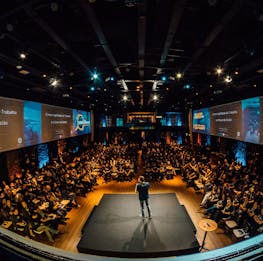Never Split the Difference Summary
Negotiating As If Your Life Depended On It
Do you want to have the edge in any negotiation? Then who better than former FBI hostage negotiator Chris Voss, to provide hands-on tactical advice on how to negotiate our way to success?
Never Split the Difference is the definitive practical guide to mastering any negotiation. Voss reveals his battle-tested strategies in high-stakes negotiations, and provides new ways of thinking about the art of negotiation.
Each chapter is a lesson. And each lesson is based on a real-life example from the author's involvement with hostage negotiations. After the storytelling, Voss explains the negotiating techniques that worked, and those that didn't. He also taps into behavioral theory and neuroscience to explain this. He wraps up each chapter with crucial lessons that are easy to remember and apply in our own lives. Because here's the thing, negotiating isn't just something police officers or lawyers have to deal with; it's a skill we all need to hone.
Voss believes that the techniques used in life or death negotiations apply to everyday conflicts. Whether we're negotiating with kidnappers, or just trying to get our kids to take a nap, the principles stay the same. His take-home trick? Make sure the person we're negotiating with feels heard and understood. Feeling listened to establishes trust, and trust is key to any negotiation.
Voss also teaches us how to deploy tactical empathy, why active listening matters, and how we can become better at active listening in order to build trust. Passive listening is, unfortunately, more prevalent than we think. Voss explains how the right questions, what he refers to as "calibrated questions," can influence our negotiating partner's perspective. This helps us to jointly work towards an outcome where neither one feels like they have to "split the difference."
Briefly, we'll explain why the old ways of negotiating don't work, how Voss redefines the negotiation game, and what tactics we can draw upon to be a successful negotiator.
Ever Been Asked To "Split the Difference?"
"Split the difference" is a euphemism for compromise. It's when we settle for only a small part of what we originally wanted.
However, what if there's a way to negotiate without making a compromise that's too substantial? In other words, how do you avoid having to "split the difference," but still negotiate calmly and reasonably?
Several years ago, Voss was invited to present his negotiation techniques at a Harvard lecture. The class instructor asked him to perform a mock negotiation with one of the students. Voss had to sell a product to his counterpart, who had a set budget to work within. Voss and the student negotiated back and forth until they agreed on the "right price." When the instructor was told what price they had settled on, she burst out laughing. She told Voss, 'You literally got every dime he had.' She was so used to seeing her students "split the difference" between the minimum selling price and the maximum budget that was allowed. But Voss had somehow convinced the student to use his entire budget willingly. To see if this was just a fluke, the instructor asked Voss to negotiate with a different student, and again, Voss walked away with the maximum amount of money. The Harvard students knew of every cutting-edge negotiating technique, so how did Voss convince them to give him their entire budget?
Well, Voss isn't just any negotiator. As a former lead hostage negotiator for the FBI, he's had to master his negotiating skills. During this time, Voss couldn't afford to "split the difference," because a bad deal, or a heavy compromise in a hostage negotiation, can cost lives. He learned that sometimes we can't compromise, but that doesn't mean we can't negotiate calmly and collaboratively.
Voss explains that asserting our demands before hearing what someone has to say is the ultimate negotiation mistake. It's equally counterproductive to think of a negotiation as a zero-sum game, where we believe the goal is to get as much out of the interaction as possible at our opponent's expense. Or, as Voss describes it, we see our counterpart as the "enemy" and the negotiation as the "battle." Equally ineffective is trying to rely on logic and rationality to persuade someone to see things our way.
Why Don't These Old Ways Work?
Here's where the psychology behind negotiating comes in.
We're all human, and as much as we like to think, thinking isn't always our forte. Emotions and irrationality sometimes get the better of us. Our brains are such, that emotion often overrides logic, leading us to make unconscious or biased choices.
For this reason, to truly master the art of negotiation, we have to do two things. First we must reframe how we view negotiations, and then we need to tap into our emotional intelligence and intuition to relate empathically to other people.
You might think, what empathy? How does someone like Voss will himself to show compassion to a kidnapper or a bank robber?
Empathy doesn't mean we have to like or agree with the other person, but it does require us to understand what they might be thinking and feeling. In short, showing empathy is establishing trust. And trust is a necessity in any negotiation, because a negotiation isn't just about trying to get things to go our way. Negotiation is about skillful interaction and communication towards a specific outcome that benefits both parties.
The problem is that negotiation is often seen as a zero-sum game, where there's a battle between enemies. So while some negotiators take an adversarial posture toward their counterparts across the table, Voss believes the person before us is our negotiating partner. This understanding leads to a more effective way to negotiate, where Instead of being adversarial, the process becomes more collaborative as we move towards a suitable outcome.
In the 1970s, when negotiation first became recognized as a field of expertise, it was based on the assumption that people acted rationally. We might work for our own advantage during a negotiation, but to think we're always rational is a stretch.
In Thinking Fast and Slow, psychologist Daniel Kahneman and economist Amos Tversky prove that we're prone to cognitive bias, causing errors in how we process information and form judgments. This results in us acting in unconsciously irrational ways. We aren't as rational and logical as we'd like to think, and our behavior isn't always predictable. Our irrational and emotional side can often trump our logical side.
For this reason, negotiation isn't just being able to reason with our counterpart; it's about being able to understand what drives them emotionally, even if this is unconscious at times. That's why tactical empathy is so important. Voss believes that good negotiators tap into intuition and emotional intelligence to establish trust, gather the information they need, and negotiate so that everyone wins.
Voss's secret to a successful negotiation is tactical empathy.
What's Tactical Empathy?
Voss believes that just because we disagree with another person's terms and conditions, and aren't willing to compromise, doesn't mean we can't show them empathy. "Tactical empathy" is how we establish trust, and trust is how we set the basis for a healthy negotiation with a fair outcome.
Tactical empathy is the act of sincerely empathizing with our counterpart's situation and then getting them to empathize with us. It's about understanding the feelings and mindset of another in the moment. It's bringing our attention to both the emotional obstacles and the potential pathways to getting to an agreement.
Why Is Empathy So Important in a Negotiation?
Empathy is the ability to describe, understand and demonstrate the needs and perspective of another person. Sympathy on the other hand, is when we feel what the other person is feeling. So empathy means we understand where another person is coming from, but we don't have to take on their emotions, agree with them, or even like them. As Voss says, 'The beauty of empathy is that it doesn't demand that you agree with the other person's ideas.'
By deploying tactical empathy, ensuring that our counterpart is heard and understood, and then getting them to understand our problem, we can negotiate fairly and collaboratively without making too heavy a compromise.
If we wish to influence how another thinks and behaves, we need to demonstrate empathic understanding. Here's how we do that.
Actively Listen and Build Trust
Any negotiation should begin with getting all the facts. 'Until you know what you are dealing with, you don't know what you are dealing with.' We need to take in as much information as we can, and to do that, we have to listen actively.
Meet the "passive listener." How often do you find yourself talking with a friend, and mid-sentence, you notice that they're not fully concentrating on what you're saying? They may be looking at their phone, or they interrupt you before you've finished your sentence. Sometimes we may be the culprits because when someone else is speaking, we're too busy formulating what to say next? Whereas active listening demands 100% of our focus. We need to mute our internal commentary to listen to what someone else is saying, and intuit what they might be feeling.
To be a good negotiator, we need to make sure that our counterpart feels genuinely heard and understood. Active listening is how we build trust, and the more someone trusts us, the more they may be willing to share, which helps us clarify what we're dealing with.
Thankfully, listening is a skill that we can develop. Here are three ways to become better active listeners: mirror, adjust tone of voice, and label emotions.
Mirror Your Counterpart
"Mirroring" is an effective way to establish trust and make someone else feel heard and understood. We can imitate their verbal or nonverbal behaviors, speech patterns, body language, vocabulary, and even tone of voice.
Voss says, 'Mirroring is generally an unconscious behavior – we're rarely aware of it when it's happening – but it's a sign that people are bonding, in sync, and establishing the kind of rapport that leads to trust.' Good friends will often use the exact words or phrases and adopt the same gestures, particularly when they're together. We instinctively mirror those we're close to, but we can also learn to mirror our counterparts during a negotiation.
In a negotiation situation, mirroring helps to establish common ground. It works because it makes the other person feel more similar to us. Highlighting similarities helps to create a sense of belonging and develop trust, which impacts on engagement levels.
As an example, Professor Richard Wiseman undertook a small experiment in mirroring with waiters in a restaurant. One group used mirroring and the other used positive reinforcement. The two groups of waiters took orders from different tables. One group used positive reinforcement, praise, and encouragement in response to each order. The other group mirrored their customers by simply repeating their orders back to them in the words they used. The result? The average tip of the waiters who mirrored, was 70% more than those who used positive reinforcement.
So the next time you're in negotiation, try to mirror the other by repeating the most important one to three words of what someone said. It's equally important to note that how we say something is just as important as what we say.
Adjust Your Tone
How often do you get upset with someone, not because of what they said, but how they said it?
Tone of voice is a powerful tool in successful negotiating. A UCLA study shows that 93% of communication is non-verbal, and nearly 40% of it has to do with the tone of voice. So learning to use our voice well is the key to win-win negotiations.
Voss says that there are three voice tones available to negotiators: the late-night FM DJ voice, the positive/playful voice, and the assertive voice. The assertive voice is often used in negotiations but comes across as declarative and (as most parents will admit to) can be counterproductive, creating pushback from our counterparts.
The late-night FM DJ voice is a low-pitch, calm, slow, reassuring tone that profoundly affects another. It's instrumental when we want to make a point. When done correctly, it helps to create an aura of authority and trustworthiness without triggering defensiveness. Voss tells a story of a bank robbery, where he had to facilitate the negotiation. Voss had to take over from his colleague Joe. To prevent the robber from getting agitated, our author adopted a calm deep voice to tell him that Joe was off duty and he was taking over. Voss's tone carried a sense of calm and reason, helping the robber not be unnerved by Joe's departure.
While some situations require a deep calm tone, others might need a more positive playful one. Our author recalls a colleague whose girlfriend was a pro-negotiator, not in the hostage sense, but in the shopping arena. While on holiday in Istanbul, she had a playful knack for bargaining down prices with local spice merchants. The merchants themselves were skilled bargainers, but her friendly approach made it difficult for them to refuse her price proposals. A playful/ positive tone helps establish ease and gives an impression that we're easy-going, trustworthy, and good-natured.
Label Emotions
Labeling is how we validate someone's emotion through simple acknowledgment. Giving someone's emotion a name shows that we identify with how that person feels, which helps foster intimacy and trust.
Voss shares the following example. A woman working for a pharmaceutical company was trying to convince a doctor to change the drugs he prescribed, to the products she sold. Initially, the doctor came across as cold and skeptical. The sales pitch was going badly, but as they chatted, she realized that he cared deeply for his patients. His body language and tone of voice were notably warmer when he spoke of his patients. She acknowledged his passion and care for his patients, and developed a rapport around his treatment philosophy. From that moment, the doctor let down his guard and listened to what she had to say. Once she had listed her product's positive attributes, he agreed to try administering the drug to his patients and placed an order that day.
Techniques such as mirroring, and using the right tone of voice show that we're actively listening. However, labeling is how we demonstrate that we sincerely understand another's "world" and truly empathize with them.
Empathic understanding is key to any negotiation. However, for a negotiation to be successful, empathy has to go both ways. Once we've established some trust, we need to get our counterparts to empathize with our situation so that they can hear and validate our viewpoint. Here's where asking the right kind of questions comes into play.
Ask Questions That Begin With "What" and "How"
During an argument, has anyone asked, 'Why did you do that?' This sounds accusatory and is likely to put our noses out of joint, which makes us defensive. A question that starts with 'what' or 'how,' can sound far less accusatory.
Calibrated questions begin with 'what' and 'how.' The magic behind calibrated questions is that they turn a negotiation into a collaborative, problem-solving session.
Calibrated questions are open-ended, problem-focused questions that help deliver the illusion of control to our counterpart, putting the issue of solving the problem in their hands. The power dynamic of negotiation shifts, and our counterpart has to consider our position in the equation and show us empathy.
Voss says, 'The ultimate calibrated question is, "How am I supposed to do that?"'
How do we apply them in daily life? Say your landlord raises your rent from $1200 to $1500 a month. The best way to avoid the rent increase and negotiate a lower rent is to empathize with the landlord's position. Once you've done that ask, 'How am I supposed to do that?' You could say, 'It seems like you think your apartment is under-valued, and you want a fair price. But how am I supposed to pay $1500 a month when I only make enough money to afford $1200?' The subtext behind this statement is, 'I value your viewpoint, could you please help me solve my problem?' If you've made your counterpart feel heard, you've built rapport. This exchange will usually result in one of two things happening. They could look for a creative solution, where you both get what you value, or they'll reduce the rent to try to accommodate you. If this still doesn't meet your needs, you can politely counter every offer. Polite counter-responses are how we can keep negotiating until we find a solution that works for all parties.
In Conclusion
Being a good negotiator can contribute significantly to business and personal success. It's a skill that can help us build better relationships, develop lasting solutions, and avoid future problems and conflicts.
We have a fundamental need to be heard and understood. Tap into this, and watch how easily you might be able to negotiate a favorable outcome. Remember to listen to understand, take in all the information your counterpart offers, make them feel heard, and use calibrated questions to get them to empathize with your situation. Finally it's about seeking a mutually beneficial solution, one that doesn't force you to "split the difference" and compromise on what matters.
Never Split the Difference is a book you'll want to recommend to everyone. However, at the same time, you'll want to keep it to yourself because it gives a competitive edge when navigating any negotiation successfully.




